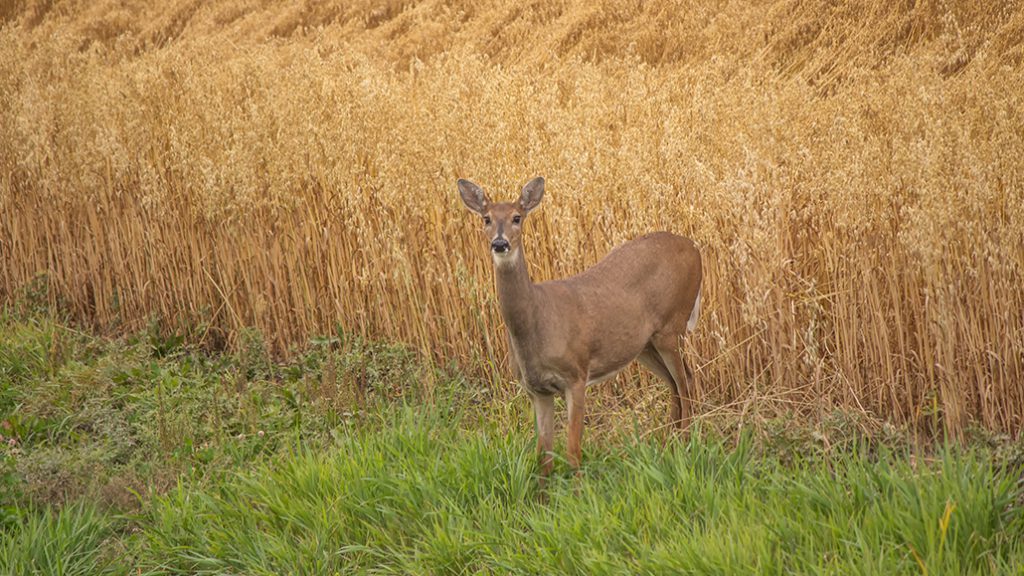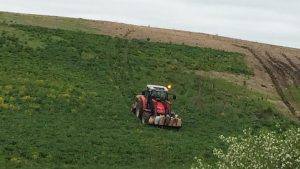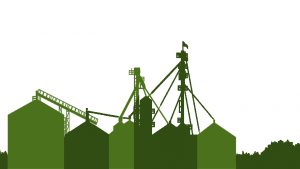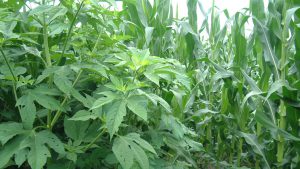Damage control
MANAGING THE IMPACT OF WILDLIFE ON YOUR CROPS

FARMERS GO TO great lengths to ensure their crop has a good start to the growing season. Not only is the best hybrid or variety selected, the appropriate herbicide and fungicide is chosen to protect the plant until it reaches a more competitive size.
But there are other factors that threaten crop yields that are harder to control.
According to the Ontario Wildlife Crop Damage and Livestock Predation Assessment Manual, wildlife damage to agricultural crops is estimated by the Ontario Soil & Crop Improvement Association (OSCIA) to cost farmers approximately $41 million in crop and livestock losses annually. According to Agricorp, reported wildlife damage claims have remained stable in frequency and severity from year to year.
“Fields or areas of fields that are adjacent to a bush are often the most impacted. The type of wildlife and the season can also impact the type of damage to crops. For example, groundhogs feed early during the harvest season on soybeans, while racoons feed later in the summer or fall on corn,” says Bianca Jamieson, Ontario Ministry of Agriculture, Food, and Rural Affairs.
Some of the common wildlife that tends to damage crops include deer, groundhogs, raccoons, and birds.
DEER
In the case of deer, the preferred crops tend to be corn, soybeans, and winter wheat.
When feeding on soybeans, deer tend to feed on young plants, preferring the newest growth on top of the plant while removing both leaves and the main stem. Feeding often slows during pod set and eventually stops as there is less new growth as the plant matures. Yield reductions can be significant, especially in smaller fields surrounded by bush. According to the OSCIA, white-tailed deer and geese cause 40 to 50 per cent of the damage to forages and wheat, and deer cause 45 per cent of soybean damage attributed to wildlife.
Damage caused by deer can occur in many stages of corn growth:
Milk stage: Peak damage usually occurs while the ears are in the milk stage
Late vegetative stage: Deer will bite the ear of corn as it begins to form. This causes the outer husk to fail to grow and the inner husk to continue growing with the ear, resulting in a smaller than normal ear and possibly without kernels. The ear will produce corn if the damage occurred after germination was complete, but the injury exposes the ear to weather and other kinds of wildlife and insect pests
Mature: Damage to mature corn includes removing kernels and dry husk
Deer will also graze on winter wheat during the winter months, compromising the crop and impacting quality and yield.
GROUNDHOGS
Groundhogs commonly feed along the edges of soybean fields, typically on young plants, often chewing off the main stem below the cotyledon and killing the young plant. If they feed on only the top part of the plant, it can recover, but yield reductions are severe in those impacted areas.
RACCOONS
In its comprehensive assessment of provincial wildlife damage to crops, OSCIA determined that raccoons accounted for most damage to corn — more than 50 per cent. Raccoons will dig holes in search of seedlings in the spring months. In the milk stage, raccoons pull husks open with their teeth and claws to expose the kernels. Husks will have a shredded look, and cobs will appear masticated with many torn seed coats remaining on the cob. Raccoons also have a tendency to pull down corn plants to feed on the developing ear in the fall.
BIRDS
Sandhill cranes and Canada geese feed on seedlings or the seed before it has time to emerge in the spring. Most birds will feed on cereals, however, black birds will also feed on corn if other food sources are not available. Birds can also increase damage originally caused by other wildlife.
“Almost all wildlife feeding is easily identified by the distinctive tracks left behind by the wildlife,” says Jamieson.
PREVENTION
There are several methods farmers can use to reduce crop damage caused by wildlife, such as installing physical barriers such as netting or fencing, using deterrents such as scarecrows or lights, and habitat manipulation or modification to deter certain behaviours, such as nesting.
For provincially managed wildlife, the Fish and Wildlife Conservation Act, 1997 generally allows property owners to manage wildlife that is causing or is about to cause damage to their property. Authorization by the Ministry of Natural Resources and Forestry (MNRF) is required prior to any actions involving deer, elk, or species at risk.
Farmers are permitted to use certain types of traps to capture furbearing mammals causing damage, or to hire a licensed trapper to do so on their behalf. MNRF district offices can provide farmers with a list of licensed trappers. Farmers may also wish to consider allowing hunters and trappers to access their lands to help manage wildlife populations and reduce conflicts. It is also illegal to use poison or use adhesives to kill, injure, or capture wildlife.
MINIMIZING FINANCIAL LOSSES
Agricorp has a number of programs designed to manage the financial risk of wildlife damage to crops:
Production Insurance: Wildlife damage is an insured peril for most crops. Producers receive a yield guarantee based on their average yields and their chosen coverage level. If wildlife, or a combination of wildlife and other insured perils, causes the producer’s yield to fall below their yield guarantee, they can receive an indemnity for the shortfall. Most plans also offer a reseeding benefit, which covers the cost of replanting damaged acres early in the growing season.
AgriStability: This protects producers against large margin declines caused by any combination of production loss, increased costs, or market conditions. If a producer’s margin falls below 70 per cent of their recent average, AgriStability helps to offset the difference.
AgriInvest: This allows producers to set money aside to recover from small income shortfalls or make investments to reduce on-farm risks. Producers can deposit one per cent of their allowable net sales into an account and receive a matching government deposit. Producers can withdraw funds from their accounts to offset the financial impact of wildlife damage, or to invest in mitigation measures. AgriInvest is delivered federally on behalf of Ontario and Canada.
It’s important for farmers to be aware and prepare for all risks their crops might face, and to have strategies and plans in place. Wildlife damage is something every operation must handle, and identifying the cause and working to prevent future damage can reduce losses in yield and financially.
For more information about Agricorp programs, contact Agricorp at 1-888-247-4999. For more information on managing conflicts with wildlife, visit the Ministry of Natural Resources and Forestry (MNRF) website at www.ontario.ca/ page/prevent-conflicts-wildlife. For more Information on hiring an agent for protection of property, visit www.ontario.ca/ page/hire-wildlife-agent. For full details around identifying wildlife causing crop damage, download the www.ofah.org/ cropmanual. •










